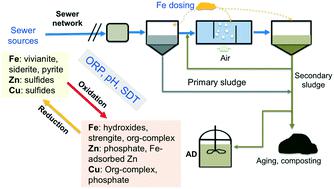当前位置:
X-MOL 学术
›
Environ. Sci.: Water Res. Technol.
›
论文详情
Our official English website, www.x-mol.net, welcomes your
feedback! (Note: you will need to create a separate account there.)
What controls the chemical speciation of abundant heavy metals during wastewater treatment: insights from combined spectroscopic and modeling analyses
Environmental Science: Water Research & Technology ( IF 3.5 ) Pub Date : 2021-09-03 , DOI: 10.1039/d1ew00497b Rixiang Huang 1
Environmental Science: Water Research & Technology ( IF 3.5 ) Pub Date : 2021-09-03 , DOI: 10.1039/d1ew00497b Rixiang Huang 1
Affiliation

|
Speciation of heavy metals (HMs) in sewage sludges (biosolids) is fundamental to understanding important physicochemical and biological processes in wastewater and sludge treatments, operation improvement, risk evaluation of biosolid land applications. Speciating even the most abundant HMs remains analytically challenging and the main processes and factors controlling the speciation remain poorly understood. In this work, we conducted meta-analysis on spectroscopic speciation data of sewage sludges with different generation and processing conditions, and revealed the consistency and variation in the chemical speciation of iron (Fe), zinc (Zn), and copper (Cu). Formation/prevalence conditions for the main chemical species identified spectroscopically were simulated using the PHREEQC code. Modeling results were consistent with experimental results and showed how specific redox conditions, elemental composition, and pH affect the prevalence of the main chemical species. Combined analysis of the spectroscopic and modeling results also revealed some discrepancies that are originated from characteristics of wastewater treatment processes and different kinetics of chemical species under redox or compositional fluctuations. Results from this work provide a comprehensive and predictive insight into the dynamic transformation of several abundant elements and their coupling during wastewater and sludge treatments.
中文翻译:

在废水处理过程中控制大量重金属的化学形态的因素:结合光谱和建模分析的见解
污水污泥(生物固体)中重金属(HMs)的形态是理解废水和污泥处理、操作改进、生物固体土地应用风险评估中重要的物理化学和生物过程的基础。即使是最丰富的 HMs 的分析仍然具有挑战性,控制物种形成的主要过程和因素仍然知之甚少。在这项工作中,我们对不同产生和处理条件的污水污泥的光谱形态数据进行了荟萃分析,揭示了铁(Fe)、锌(Zn)和铜(Cu)化学形态的一致性和变化。使用 PHREEQC 代码模拟光谱鉴定的主要化学物质的形成/流行条件。建模结果与实验结果一致,并显示了特定的氧化还原条件、元素组成和 pH 值如何影响主要化学物质的流行。光谱和建模结果的组合分析还揭示了一些差异,这些差异源于废水处理过程的特征和氧化还原或成分波动下化学物质的不同动力学。这项工作的结果为废水和污泥处理过程中几种丰富元素的动态转化及其耦合提供了全面和预测性的见解。光谱和建模结果的组合分析还揭示了一些差异,这些差异源于废水处理过程的特征和氧化还原或成分波动下化学物质的不同动力学。这项工作的结果为废水和污泥处理过程中几种丰富元素的动态转化及其耦合提供了全面和预测性的见解。光谱和建模结果的组合分析还揭示了一些差异,这些差异源于废水处理过程的特征和氧化还原或成分波动下化学物质的不同动力学。这项工作的结果为废水和污泥处理过程中几种丰富元素的动态转化及其耦合提供了全面和预测性的见解。
更新日期:2021-09-15
中文翻译:

在废水处理过程中控制大量重金属的化学形态的因素:结合光谱和建模分析的见解
污水污泥(生物固体)中重金属(HMs)的形态是理解废水和污泥处理、操作改进、生物固体土地应用风险评估中重要的物理化学和生物过程的基础。即使是最丰富的 HMs 的分析仍然具有挑战性,控制物种形成的主要过程和因素仍然知之甚少。在这项工作中,我们对不同产生和处理条件的污水污泥的光谱形态数据进行了荟萃分析,揭示了铁(Fe)、锌(Zn)和铜(Cu)化学形态的一致性和变化。使用 PHREEQC 代码模拟光谱鉴定的主要化学物质的形成/流行条件。建模结果与实验结果一致,并显示了特定的氧化还原条件、元素组成和 pH 值如何影响主要化学物质的流行。光谱和建模结果的组合分析还揭示了一些差异,这些差异源于废水处理过程的特征和氧化还原或成分波动下化学物质的不同动力学。这项工作的结果为废水和污泥处理过程中几种丰富元素的动态转化及其耦合提供了全面和预测性的见解。光谱和建模结果的组合分析还揭示了一些差异,这些差异源于废水处理过程的特征和氧化还原或成分波动下化学物质的不同动力学。这项工作的结果为废水和污泥处理过程中几种丰富元素的动态转化及其耦合提供了全面和预测性的见解。光谱和建模结果的组合分析还揭示了一些差异,这些差异源于废水处理过程的特征和氧化还原或成分波动下化学物质的不同动力学。这项工作的结果为废水和污泥处理过程中几种丰富元素的动态转化及其耦合提供了全面和预测性的见解。











































 京公网安备 11010802027423号
京公网安备 11010802027423号